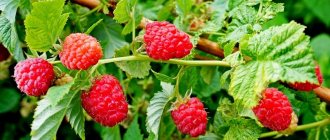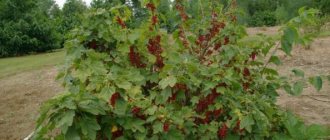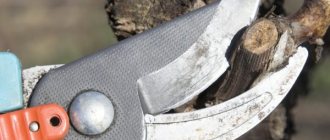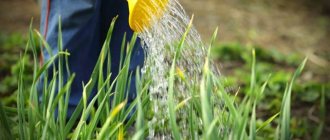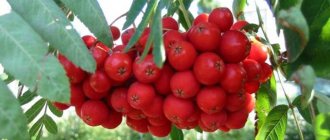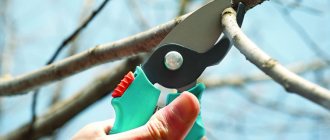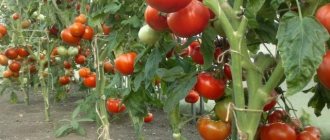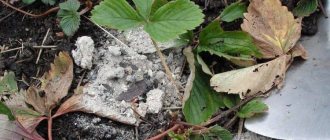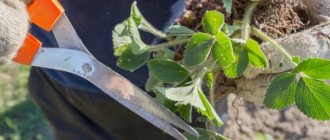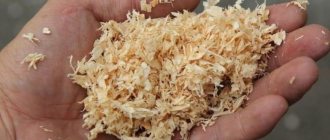Why feed strawberries in the fall?
The gardening season may be coming to an end, but before you start your winter holidays, you should start thoroughly feeding any varieties of strawberries. Strawberries themselves are not a frost-resistant crop; they may not survive frosts of more than -20 degrees, which is why they are always mulched for the winter, and in winter they throw a lot of snow on the garden bed. If you don't do this, she will freeze.
But what does feeding have to do with it? Fertilizing strawberries in the fall improves the composition of the soil, making it looser, more nutritious, and “comfortable” for the roots of the crop. Fertilizers allow plants to recover faster after fruiting, and also increase resistance to diseases and pests. But what’s more important is that fertilized strawberries withstand frost more resistantly. Even if there is little snow, the chance that it will freeze at -25 degrees is extremely small!
Fertilized strawberries are more resistant to frost
So it is highly recommended to fertilize strawberries in the fall, especially if the bushes were sick in the summer or fruiting was very high.
Useful video
Care of strawberries after harvest - video
Caring for strawberries in the fall, feeding and protection from diseases and pests - video
Nutrient supplements in autumn are very important for the full development of strawberry bushes. The abundance of flowering, the number of flowers, ovaries and future harvest, the taste and size of the berries depend on the correct choice of fertilizer. The main thing is that fertilizers are supplied in the required volume. Excess in this case will only do harm. With the right approach, the root system will receive a sufficient amount of nutrients and spend the winter with dignity, and the crops will certainly be rewarded with a generous harvest of healthy fruits.
When is the best time to feed strawberries in the fall?
Also check out these articles
- Asiatic lily flower
- Grape variety Bazhena
- Grape variety Long-awaited
- Which soil is best for seedlings
Fertilizing strawberries in the fall always occurs during the period when the crop has already been harvested and the plant is preparing for the dormant period. If the bushes are still bearing fruit, fertilizing should be postponed until it is finished. The reason is that autumn feeding is not intended to increase the yield or quality of fruits, but to strengthen the plant’s defense mechanisms (improve frost resistance, resistance to an aggressive environment). In addition, the bushes are weakened after fruiting, and fertilizer is the simplest, fastest and most effective method of restoring them.
Precisely because strawberries finish fruiting at different times, it is difficult to name the exact period for fertilizing. This could be September, October or November, or maybe all three months at once, because in the fall you can first fertilize with liquid fertilizer, in early September. Then, at the end of September, spray the strawberry leaves with an infusion of wood ash, and in mid-November, pour organic mulch or mineral fertilizers onto the bed and mix them while digging the rows with the ground.
So you should focus on your own capabilities, the needs of the land and strawberries. If the bushes are in poor condition, it is worth doing at least two feedings in the fall. If it is normal, you can limit yourself to adding dry matter before winter.
How to fertilize strawberries in the fall for a good harvest
You can feed strawberry bushes in the fall not only with mineral or organic fertilizers, but also with folk remedies. The main thing is to maintain the correct proportions of the components so as not to harm the plant, because Too much complementary feeding can be dangerous for strawberries.
Organic fertilizers
- Manure and mullein make the soil loose and airy. This additive gives the root system new strength and restores the plant after fruiting.
Cow or horse manure is mixed with water in a ratio of one to ten and left to infuse. After two to three days, 500 to 700 milliliters are poured around each bush.
Add one liter of mullein infusion to ten liters of water and water it under the root. You can strengthen this solution with one glass of wood ash and two large spoons of superphosphate. Each plant will need 300 - 400 milliliters.
To prepare slurry you will need eight liters of water and one liter of manure. Insist for three days. Water the ground only between the rows of strawberry bushes.
- Bird droppings in strong concentrations can cause irreparable harm to plants, so fertilizers must be prepared and applied strictly according to the instructions.
It is recommended to pour the chicken manure solution between the rows to avoid burning the crops. Infuse it for a week. One kilogram of litter per bucket of water. Add 20 liters of water to one liter of prepared infusion.
- Compost made from food and plant residues is a source of nutrients that strawberries need to recover in the autumn. When planting seedlings, a handful of compost is added to each planting hole. For mature bushes, compost acts as mulch (after pruning).
- Humus , namely leaf humus, is the simplest and most effective fertilizer in the fall. Strawberry beds can be mulched with this nutrient mixture, and it will not only feed the berry crops, but also protect them from the cold in winter. For each square meter you will need about ten kilograms.
When planting in autumn, humus is added directly to the holes.
- Bone meal contains large amounts of calcium and phosphorus. It must be added when planting young strawberry bushes in each hole. This fertilizer is used once every three years.
- Wood ash replaces mineral fertilizers with a high content of phosphorus and potassium. It is ideal as an autumn fertilizer as it does not contain nitrogen. It is added to moist soil (about one glass per square meter), after which the berry plot is watered abundantly. You can also prepare liquid fertilizer.
Add two glasses of ash to a large bucket of water, leave for a day and pour about 500 milliliters of solution under each plant.
- Green manure is the key to a generous harvest for many crops, including strawberries. Crushed stems of lupine or bean green manure are sprinkled between the bushes and crushed with soil. When planting seedlings, this fertilizer can be applied to the holes.
Mineral compositions
- Superphosphate (40 - 50 grams) and potassium sulfate (30 grams) are dissolved in a large bucket of water, watered under the bush and mulch is immediately applied.
The effectiveness of superphosphate in its own form is not very high, but in combination with potassium sulfate the result will be excellent.
- Potassium promotes the formation of fruits, and also improves their taste, adds sweetness and promotes longer storage. A nutrient solution of a liter of water and two grams of potassium salt is poured into the rows.
To restore the root part, you will need a bucket of water and 20 grams of potassium and nitrophoska. One liter - per bush.
Reference!
It is not recommended to use potassium chloride for preparing fertilizers; strawberries react negatively to it.
- Nitroammofoska (two large spoons) and potassium salt (20 grams) are poured into a large bucket of water and the bushes are watered after pruning. For one plant – one liter. The solution increases resistance to disease, strengthens the immune system and prepares plants for winter.
- Phytosporin, when applied to the soil in the autumn, helps to increase productivity several times and also protects crops from possible pests. The soil becomes nutritious and useful for the development of strawberries.
- Kemira is a ready-made fertilizer that must be diluted according to the recommendations on the package. Usually, for a square of land, take a bucket of water and 50 grams of the product.
- Phosphorite flour is used as a top dressing once every three to four years. It is during this period of time that the effect of its presence in the soil will be visible - this will have a positive effect on the yield of strawberries.
Folk remedies
- Urea (about 30 grams) is dissolved in a bucket of water, after which each plant is watered with a one-liter solution.
- Bordeaux mixture strengthens the immunity of weakened crops before wintering and increases resistance to pests and diseases.
- Yeast (regular baker's yeast) is diluted in water, left for a day and used to feed bushes. For a bucket of water - one hundred grams of fresh yeast.
You can prepare a solution from one hundred grams of dry yeast and two liters of warm water, but before use, add five parts of water to one part of such a solution.
If there is no yeast, you can take regular bread (one kilogram) and three liters of water, and leave the mixture for a week. The resulting slurry is applied to the soil around the bushes and lightly sprinkled with earth.
- Hydrogen peroxide enriches the earth with oxygen. Top dressing is prepared from five liters of water and one hundred grams of the drug. For one bush - 200 - 300 milliliters.
- Ammonia has an excellent effect on crops immediately after autumn pruning; it supports them and gives additional strength. After applying it, a bountiful harvest next season is guaranteed.
The solution is prepared from ten liters of water, 150 milliliters of ammonia, three drops of iodine solution. Apply by watering at the root.
- Boric acid in combination with manganese (two grams of each preparation) and water (a large bucket) is a very useful nutrient solution for strawberries in the fall.
- Herbal infusion is prepared from fresh nettle or any weed and is used throughout the summer and autumn. The container is filled two-thirds with crushed plants, filled with warm water and left to ferment and infuse for seven to ten days. Before applying to the soil, filter and dilute with water (for each liter of water - 50 milliliters of infusion).
- Fermented milk products saturate the soil with several useful substances at once - nitrogen, sulfur, calcium, phosphorus and others. You can use only whey for irrigation, or you can mix it with wood ash or manure.
Preparatory activities
Before you start fertilizing strawberries in the fall, you need to carry out several preparatory procedures.
Pruning strawberry bushes
- First, the bed is inspected, all the tendrils that the bushes have sprouted, if not needed, are removed.
- It is also necessary to trim bad leaves from bushes. This includes leaves damaged by pests, diseased ones, those that are simply withered or almost completely dry. Only the greenest and most beautiful ones are left.
- Now all weeds are removed. There is no benefit from them - they only draw juices from the ground, especially if they are perennial weeds.
How to prepare strawberries for winter
After harvesting, caring for strawberries does not end. Plants need to be watered, fertilized, pruned and mulched. Without the necessary manipulations, it will be quite difficult for plants to endure the harsh cold winter.
- Watering should be done as needed. September is often dry and hot. To prevent the bushes from suffering, they need to be given enough moisture, but they should not be overwatered, as the strawberry roots may begin to rot.
- Whether to trim the leaves is an eternal dilemma for gardeners. Experts often argue on this topic. Proponents of pruning argue that the procedure increases yields the following season. Their opponents are adherents of the natural process.
- Cover strawberries only in regions with a harsh climate and little snowy winters. Most often, good snow cover is sufficient for plants. It protects strawberries from freezing and provides good moisture in the spring.
- If shelter is required, it is recommended to use a good material, such as spunbond or Agrotex. Fallen leaves also become excellent insulation.
It is believed that up to 60 grams of covering material should be used per square meter. When using spunbond, you must first install the arcs and stretch the material on top. If possible, spruce branches are used for insulation. It preserves plants well and prevents freezing. Strawberries need to be covered after the first frost. This will harden the plants. Usually the first frosts are not severe and do not damage the bushes.
Pruning is done in August after harvest. Only the leaves and tendrils are removed; the stems do not need to be touched so as not to harm the plant. Use sharp garden shears for pruning.
How to fertilize strawberries in the fall depends on the capabilities and preferences of gardeners. Many people prefer organics and natural ingredients. For some, mineral preparations remain the best option. Comprehensive and timely feeding is important. The plant must receive the necessary microelements. Only in this case the harvest will be as large and high quality as possible.
How to use fertilizers?
We recommend reading our other articles
- Tomato variety Red Riding Hood
- Late blight of potatoes
- Angora rabbit
- The best varieties of blue plums
As soon as the bed is cleaned, autumn fertilizing of strawberries is carried out. The feeding method depends on the form in which the fertilizer is used. So, for example, you simply water the beds with liquid so that the product does not get on the strawberries.
Important! Fertilizing strawberries in the fall with any liquid fertilizers is carried out only until the end of September. Their later use may cause the death of strawberry roots during frosts.
However, in the fall, for the most part, granular or dry fertilizer is used - it is more useful, since it is considered long-lasting. Dry and granular mixtures are always added for digging. The reason is that they contain a lot of volatile substances. If the ground is not dug up, they will simply evaporate and will not bring any benefit. To begin with, minerals or organic fertilizer are scattered over the garden bed, between the strawberries in the required quantity, and then the soil is loosened with a hoe. As it is loosened, the fertilizer penetrates into the soil.
Fertilizing strawberries in the fall with any liquid fertilizers is carried out only until the end of September
Foliar feeding is rarely carried out in the fall, but it is they that can be very useful for strawberries. Around September, when the temperature drops rapidly, the plants weaken and, in order to survive, begin to draw juices and nutrients from the leaves. Therefore, strawberries (its leaves) can quickly turn yellow and dry out in the fall. And therefore, foliar feeding will not hurt her. It is carried out using the most primitive method - from a spray bottle into which nutritious fertilizer is poured.
When to fertilize
Fertilizer is an important process in caring for garden plants. Experts have developed a strict feeding schedule that must be adhered to:
- in the spring before awakening, when the snow melts and the growing season begins;
- in summer, after harvesting fruits;
- in the fall, in the first ten days of September before the onset of frost.
If remontant strawberries grow on the site, then the timing of feeding will have to be adjusted. In September it still bears fruit. In such a situation, you need to be in time before the first frost. This is followed by two stages of feeding: on green leaves and before cold weather.
Organic fertilizers for strawberries
Fertilizing strawberries in the fall with organic fertilizers is preferable. These fertilizers can be used as infusions or in dry form, while the gardener knows for sure that the substance will not harm the plant and its fruits next year.
- Wood ash can be used as a dry product - it is scattered on the ground (150 g/m2 of land). The second option is to make an infusion from the ash and spray the strawberries. For infusion, pour 2 cups of ash with a liter of boiling water. This mixture should be boiled for 15 minutes over low heat, then cooled. Before use, it is mixed with 10 liters of water.
- Vermicompost is used in liquid form for autumn feeding of strawberries. They buy it in the store. Dilute according to the instructions (to reduce concentration) and use as directed. It is usually the soil that is watered. The substance should not get on the leaves.
- Chicken droppings can harm or help increase crop yields.
For 1 part of litter (granulated or dry), take 10 liters of water. The mixture is infused and after 2 days it is watered between the rows. The product should not get on the strawberries themselves, otherwise they will burn. Mown grass and sedirats are a kind of mulch - Humus can be diluted with water and watered the beds or used clean. In the case of infusion, 10 parts of water are taken for 1 part of humus; after 2 days, the mixture is used for irrigation. But most often, gardeners use it in a different way - they simply scatter it between rows and strawberry bushes, and then loosen the ground or leave it as mulch.
- Lupine stems or grass clippings are crushed; you can use bean green manure instead. After this, they are laid out between the rows of strawberries and sprinkled with soil on top. As they rot, they will release useful microelements and nourish the soil and strawberries. But, in addition, this is a kind of mulch that will be an excellent insulation for strawberries for the winter.
Autumn treatment of strawberries with copper sulfate
This drug is considered a universal remedy that is widely used in the garden. Experienced summer residents always have copper sulfate on hand, as it helps get rid of powdery mildew and other diseases.
To process the berries, you need to stir 3 g of blue stone in a bucket of water. We spray the plant and then cover it so that it does not die in winter.
There is another solution for treating Victoria. In 3 liters of boiled, cooled water, stir 5 g of copper sulfate and 200 g of grated laundry soap. Mix everything thoroughly for several minutes. Pour the liquid into a spray bottle and spray the bushes.
Mineral autumn fertilizing
Potassium and phosphorus are the two most basic fertilizers that the soil and strawberries need in the fall. Fertilizing strawberries in the fall is carried out with mixtures that contain an abundance of potassium and phosphorus, and there should be more potassium. As for nitrogen, it can be up to 5% or less.
- 20 g of potassium salt and 10 g of superphosphate in granules or any other form are dissolved in 12 liters of water. This mixture should be watered between the strawberry rows.
- 20 g of potassium salt is mixed with 30 g of nitrophoska, and then dissolved in 10 liters of warm water. The resulting mixture is watered into the bed between the bushes.
- “Kemira autumn” is one of the few types of mineral fertilizers that almost all gardeners respond positively to.
Approximately 50 g of the substance is taken per square meter of bed. It is simply scattered on the ground, and then weeded to be incorporated into the ground. Approximately 50 g of “Autumn Kemira” is taken per square meter of bed.
Important! When using “Autumn Kemira” or any other fertilizer for feeding strawberries in the fall, you must not allow the substance to get into the plant’s rosette, otherwise it will die in a matter of days.
What components do strawberries need in autumn?
Before planting seedlings, it is recommended to add organic and mineral fertilizers to the soil - compost, manure, bird droppings, potassium chloride, superphosphate. Young plants require mixed fertilizers with microelements. For example, when planting seedlings, a mixture of wood ash, compost and garden soil is added to the hole, and after two weeks - mineral fertilizer with potassium and phosphorus.
Reference!
Organic fertilizers have a positive effect on soil fertility and a long-term effect on plants, while mineral fertilizers have a positive effect on the condition and development of plant crops (they are absorbed faster than organic matter).
Plants that have finished bearing fruit require complete restoration, and for this you can use various fertilizers - complex, mixed, purchased, prepared according to folk recipes.
Mixed fertilizers
Fertilizing strawberries in the fall with mixed fertilizers is quite popular, as it works for a very long time after being applied to the ground. You can use 250 g of ash, 30 g of nitrophoska and 20 g of potassium chloride. All three components must be mixed with 10 liters of water and poured over the strawberries. A liter of the substance is used per bush.
Dry mixed fertilizers are usually also made from humus, superphosphate and potassium substances. The ratio largely depends on the type of land, the average for normal soil of medium looseness: 2.5 kg of humus, 20 g of superphosphate and 10 g of potassium fertilizer per square meter of land.
Important! The application rates for organic, mineral and mixed fertilizers may differ depending on the type and quality of the soil, as well as the variety of strawberries.
Optimal timing for fertilizing in the fall
When the movement of juices along the stems slows down, and this happens approximately two weeks after harvesting the last fruits, you can begin autumn feeding. Usually there are two of them: soon after the end of fruiting and after autumn pruning of berry bushes (this is about six weeks after the first).
The favorable period for applying fertilizers for strawberry bushes is September - October, but it may vary depending on the climate of the area and weather conditions, as well as on the variety of strawberry. For example:
- in cold Siberian regions - from August 20 to September 10;
- in Moscow and St. Petersburg, in the Urals and in central Russia - from September 1 to 20;
- in the southern regions - until the end of October - beginning of November.
Read more in the article: When to prune strawberries after fruiting
How to feed strawberries during autumn planting?
Before planting strawberries in the fall, the soil is usually fertilized to increase its nutritional value. But not all fertilizers are suitable for this. Below are the substances that are recommended by gardeners and are most effective.
Fertilizers are not applied until spring, but it is possible and even necessary to mulch
- Vermicompost in dry form is added to the ground before planting strawberries, dug up along with the soil and left for 1-2 weeks, and only after that you can start planting the crop.
- For 1 sq. per meter of plot, take 3 kg of compost or humus, 35 g of superphosphate and 10 g of potassium chloride. This mixture is very nutritious, but also long-lasting. Seedlings in such soil quickly take root, and the soil becomes so good that many gardeners the next year do not feed strawberries at all, except perhaps with nitrogen substances, and then only if necessary. A similar mixture is used for annual autumn feeding of strawberries, but in a lower concentration, since more nutrients are needed for planting.
Fertilizing strawberries in the fall if the plant was planted a couple of months ago is not carried out - this makes no sense. Fertilizers are not applied until spring, but it is possible and even necessary to mulch the bed with peat, compost, straw or sawdust to protect young seedlings from severe winter frosts.
How to feed strawberries in the fall with mineral fertilizers
In addition to organic matter, it is permissible to use mineral fertilizers in the fall.
Such complex formulations contain the most essential nutrients in optimal concentrations.
In autumn, you need to give preference to potassium-phosphorus compounds.
For example, potassium salt (20 g per 10 l of water) and superphosphate (10 g per 10 l of water) are added to the beds.
You can immediately feed with complex fertilizer. Usually nitrophoska is used. A solution is prepared from it (2 tablespoons per bucket of water) and watered at the roots of the strawberries.
Also nitrophoska when planting new rosettes of plants. In this case, 40 grams of product are consumed per plant. The nitrophoska is poured into the hole and then mixed with soil.
